Comprehensive Study of Natural Radioactivity in Building Materials: A Case Study in Ica, Peru
Abstract
1. Introduction
2. Materials and Methods
2.1. Sample Collection and Preparation
2.2. Measurement of Natural Radioactivity
2.3. Measurement of Radon Mass Exhalation Rates
2.4. Radiological Parameters
2.4.1. Gamma Index
2.4.2. External Hazard Index
2.4.3. Internal Hazard Index
2.4.4. Absorbed Gamma Dose Rate
2.4.5. Annual Effective Doses Rate ()
3. Results and Discussion
3.1. Testing of Sealing Methods for Cylindrical Plastic Containers Used in Gamma Spectrometry Measurements
3.2. Activity Concentrations of 226Ra, 232Th, and 40K
3.3. Radon Mass Exhalation Rate and Radon Emanation Fraction
3.4. Radiological Parameters
4. Conclusions
Author Contributions
Funding
Informed Consent Statement
Data Availability Statement
Acknowledgments
Conflicts of Interest
References
- Sonkawade, R.; Kant, K.; Muralithar, S.; Kumar, R.; Ramola, R. Natural radioactivity in common building construction and radiation shielding materials. Atmos. Environ. 2008, 42, 2254–2259. [Google Scholar] [CrossRef]
- Ramachandran, T. Background radiation, people and the environment Iran. J. Radiat. Res. 2011, 9, 63–76. [Google Scholar]
- Lecomte, J.; Shaw, P.; Liland, A.; Markkanen, M.; Egidi, P.; Andresz, S.; Mrdakovic-Popic, J.; Liu, F.; da Costa Lauria, D.; Okyar, H.; et al. ICRP publication 142: Radiological protection from naturally occurring radioactive material (NORM) in industrial processes. Ann. ICRP 2019, 48, 5–67. [Google Scholar] [CrossRef] [PubMed]
- Anjos, R.M.d.; Ayub, J.J.; Cid, A.S.; Cardoso, R.; Lacerda, T. External gamma-ray dose rate and radon concentration in indoor environments covered with Brazilian granites. J. Environ. Radioact. 2011, 102, 1055–1061. [Google Scholar] [CrossRef] [PubMed]
- Ramola, R.; Gusain, G.; Badoni, M.; Prasad, Y.; Prasad, G.; Ramachandran, T. 226Ra, 232Th and 40K contents in soil samples from Garhwal Himalaya, India, and its radiological implications. J. Radiol. Prot. 2008, 28, 379. [Google Scholar] [CrossRef] [PubMed]
- Coletti, C.; Brattich, E.; Cinelli, G.; Cultrone, G.; Maritan, L.; Mazzoli, C.; Mostacci, D.; Tositti, L.; Sassi, R. Radionuclide concentration and radon exhalation in new mix design of bricks produced reusing NORM by-products: The influence of mineralogy and texture. Constr. Build. Mater. 2020, 260, 119820. [Google Scholar] [CrossRef]
- UNSCEAR. Sources and Effects of Ionizing Radiation; United Nations: New York, NY, USA, 2000. [Google Scholar]
- Nunes, L.J.R.; Curado, A.; Graça, L.; Soares, S.; Lopes, S.I. Impacts of Indoor Radon on Health: A Comprehensive Review on Causes, Assessment and Remediation Strategies. Int. J. Environ. Res. Public Health 2022, 19, 3929. [Google Scholar] [CrossRef]
- Chambers, D.B. Thoron and decay products, beyond UNSCEAR 2006 Annex E. Radiat. Prot. Dosim. 2010, 141, 351–356. [Google Scholar] [CrossRef]
- Jasaitis, D.; Pečiulienė, M. Natural Radioactivity and Radon Exhalation from Building Materials in Underground Parking Lots. Appl. Sci. 2021, 11, 7475. [Google Scholar] [CrossRef]
- Omori, Y.; Tokonami, S.; Sahoo, S.K.; Ishikawa, T.; Sorimachi, A.; Hosoda, M.; Kudo, H.; Pornnumpa, C.; Nair, R.R.K.; Jayalekshmi, P.A.; et al. Radiation dose due to radon and thoron progeny inhalation in high-level natural radiation areas of Kerala, India. J. Radiol. Prot. 2016, 37, 111. [Google Scholar] [CrossRef]
- Ishimori, Y.; Lange, K.; Martin, P.; Mayya, Y.; Phaneuf, M. Measurement and Calculation of Radon Releases from NORM Residues; IAEA: Vienna, Austria, 2013. [Google Scholar]
- Andersen, C.E. Radon-222 Exhalation from Danish Building Materials: H+ H Industri A/S Results; Technical Report; Risoe National Laboratory: Roskilde, Denmark, 1999. [Google Scholar]
- Hassan, N.M.; Hosoda, M.; Ishikawa, T.; Sorimachi, A.; Sahoo, S.K.; Tokonami, S.; Fukushi, M. Radon migration process and its influence factors; review. Jpn. J. Health Phys. 2009, 44, 218–231. [Google Scholar] [CrossRef]
- Chen, J.; Rahman, N.M.; Atiya, I.A. Radon exhalation from building materials for decorative use. J. Environ. Radioact. 2010, 101, 317–322. [Google Scholar] [CrossRef]
- Liza, R.; Pereyra, P.; Rau, J.; Guzman, M.; Sajo-Bohus, L.; Palacios, D. Assessment of Natural Radioactivity and Radon Exhalation in Peruvian Gold Mine Tailings to Produce a Geopolymer Cement. Atmosphere 2023, 14, 588. [Google Scholar] [CrossRef]
- Pereyra, P.; Guevara-Pillaca, C.J.; Liza, R.; Pérez, B.; Rojas, J.; Vilcapoma L, L.; Gonzales, S.; Sajo-Bohus, L.; López-Herrera, M.E.; Palacios Fernández, D. Estimation of Indoor 222Rn Concentration in Lima, Peru Using LR-115 Nuclear Track Detectors Exposed in Different Modes. Atmosphere 2023, 14, 952. [Google Scholar] [CrossRef]
- Rivera, R. Realidad y Perspectivas de los Minerales Radioactivos en el Peru. INGEMMET. 2010. Available online: https://portal.ingemmet.gob.pe/documents/73138/202784/P11_Expo_Uranio.pdf/3bf404af-97c8-4b48-84e2-f84e0e1e5d9b (accessed on 24 October 2023).
- Vidmar, T.; Vodenik, B. Extended relative method of activity determination. Appl. Radiat. Isot. 2010, 68, 2421–2424. [Google Scholar] [CrossRef]
- Lépy, M.C.; Bé, M.M.; Piton, F. ETNA (Efficiency Transfer for Nuclide Activity Measurement): Software for Efficiency Transfer and Coincidence Summing Corrections in Gamma-Ray Spectrometry; Note Technique LNHB/01/09/A; LNHB: Gif-sur-Yvette Cedex, France, 2004; Volume 1. [Google Scholar]
- Stajic, J.; Nikezic, D. Measurement of radon exhalation rates from some building materials used in Serbian construction. J. Radioanal. Nucl. Chem. 2015, 303, 1943–1947. [Google Scholar] [CrossRef]
- Kovler, K.; Perevalov, A.; Steiner, V.; Metzger, L. Radon exhalation of cementitious materials made with coal fly ash: Part 1–scientific background and testing of the cement and fly ash emanation. J. Environ. Radioact. 2005, 82, 321–334. [Google Scholar] [CrossRef]
- Gutiérrez-Álvarez, I.; Martín, J.; Adame, J.A.; Grossi, C.; Vargas, A.; Bolívar, J. Applicability of the closed-circuit accumulation chamber technique to measure radon surface exhalation rate under laboratory conditions. Radiat. Meas. 2020, 133, 106284. [Google Scholar] [CrossRef]
- López-Coto, I.; Mas, J.; Bolivar, J.; García-Tenorio, R. A short-time method to measure the radon potential of porous materials. Appl. Radiat. Isot. 2009, 67, 133–138. [Google Scholar] [CrossRef]
- Cosma, C.; Cucoş-Dinu, A.; Papp, B.; Begy, R.; Sainz, C. Soil and building material as main sources of indoor radon in Băiţa-Ştei radon prone area (Romania). J. Environ. Radioact. 2013, 116, 174–179. [Google Scholar] [CrossRef]
- Tuccimei, P.; Castelluccio, M.; Soligo, M.; Moroni, M. Radon exhalation rates of building materials: Experimental, analytical protocol and classification criteria. In Building Materials: Properties, Performance and Applications; Nova Science Publishers: Hauppauge, NY, USA, 2009; pp. 259–274. [Google Scholar]
- Righi, S.; Bruzzi, L. Natural radioactivity and radon exhalation in building materials used in Italian dwellings. J. Environ. Radioact. 2006, 88, 158–170. [Google Scholar] [CrossRef]
- European Commission. Radiation Protection 112: Radiological protection principles concerning the natural radioactivity of building materials. Nucl. Saf. Civ. Prot. 1999. Available online: https://energy.ec.europa.eu/system/files/2014-11/112_0.pdf (accessed on 24 October 2023).
- Khandaker, M.U.; Jojo, P.; Kassim, H.; Amin, Y. Radiometric analysis of construction materials using HPGe gamma-ray spectrometry. Radiat. Prot. Dosim. 2012, 152, 33–37. [Google Scholar] [CrossRef]
- Beretka, J.; Mathew, P. Natural radioactivity of Australian building materials, industrial wastes and by-products. Health Phys. 1985, 48, 87–95. [Google Scholar] [CrossRef]
- Raghu, Y.; Ravisankar, R.; Chandrasekaran, A.; Vijayagopal, P.; Venkatraman, B. Assessment of natural radioactivity and radiological hazards in building materials used in the Tiruvannamalai District, Tamilnadu, India, using a statistical approach. J. Taibah Univ. Sci. 2017, 11, 523–533. [Google Scholar] [CrossRef]
- Othman, S.Q.; Ahmed, A.H.; Mohammed, S.I. Natural radioactivity and radiological risk assessment due to building materials commonly used in Erbil city, Kurdistan region, Iraq. Environ. Monit. Assess. 2023, 195, 140. [Google Scholar] [CrossRef] [PubMed]
- UNSCEAR. Sources and Effects of Ionizing Radiation, United Nations Scientific Committee on the Effects of Atomic Radiation; United Nations Publication: New York, NY, USA, 2008. [Google Scholar]
- Scholten, J.C.; Osvath, I.; Pham, M.K. 226Ra measurements through gamma spectrometric counting of radon progenies: How significant is the loss of radon? Mar. Chem. 2013, 156, 146–152. [Google Scholar] [CrossRef]
- Bonczyk, M.; Samolej, K. Testing of the radon tightness of beakers and different types of sealing used in gamma-ray spectrometry for 226Ra concentration determination in NORM. J. Environ. Radioact. 2019, 205, 55–60. [Google Scholar] [CrossRef] [PubMed]
- Syam, N.S.; Lim, S.; Lee, H.Y.; Lee, S.H. Determination of radon leakage from sample container for gamma spectrometry measurement of 226Ra. J. Environ. Radioact. 2020, 220, 106275. [Google Scholar] [CrossRef]
- Frutos-Puerto, S.; Pinilla-Gil, E.; Andrade, E.; Reis, M.; Madruga, M.J.; Rodríguez, C.M. Radon and thoron exhalation rate, emanation factor and radioactivity risks of building materials of the Iberian Peninsula. PeerJ 2020, 8, e10331. [Google Scholar] [CrossRef]
- Valentin, J.; Clarke, R.H.; GonzálezY, A.J.; Alexakhin, R.M.; Sasaki, Y.; Holm, L.-E.; Streffer, C.; Boice jr, J.D.; Mettler jr, F.A.; Sugier, A.; et al. The 2007 Recommendations of the International Commission on Radiological Protection; Elsevier: Oxford, UK, 2007; Volume 37. [Google Scholar] [CrossRef]
- Tene, T.; Gomez, C.V.; Usca, G.T.; Suquillo, B.; Bellucci, S. Measurement of radon exhalation rate from building materials: The case of Highland Region of Ecuador. Constr. Build. Mater. 2021, 293, 123282. [Google Scholar] [CrossRef]
- Herrera, D.C.; Ramirez, J.G.; Munera, H.A. Preliminary study of radiation doses from some natural materials used by the construction industry in Colombia. In Proceedings of the IRPA 12: 12th International Congress of the International Radiation Protection Association (IRPA): Strengthening Radiation Protection Worldwide, Buenos Aires, Argentina, 19–24 October 2008. [Google Scholar]
- Szabó, Z.; Völgyesi, P.; Nagy, H.; Szabó, C.; Kis, Z.; Csorba, O. Radioactivity of natural and artificial building materials–a comparative study. J. Environ. Radioact. 2013, 118, 64–74. [Google Scholar] [CrossRef]
- Imani, M.; Adelikhah, M.; Shahrokhi, A.; Azimpour, G.; Yadollahi, A.; Kocsis, E.; Toth-Bodrogi, E.; Kovács, T. Natural radioactivity and radiological risks of common building materials used in Semnan Province dwellings, Iran. Environ. Sci. Pollut. Res. Int. 2021, 28, 41492–41503. [Google Scholar] [CrossRef]
- Lewicka, S.; Piotrowska, B.; Łukaszek-Chmielewska, A.; Drzymała, T. Assessment of natural radioactivity in cements used as building materials in Poland. Int. J. Environ. Res. Public Health 2022, 19, 11695. [Google Scholar] [CrossRef]
- ukaszek-Chmielewska, A.; Girard, M.; Wojtkowski, K.; Isajenko, K.; Piotrowska, B. Analysis of natural radionuclide concentrations in selected building materials available on the domestic market. In Proceedings of the SHS Web of Conferences; EDP Sciences: Gdańsk-Nynäshamn, Poland, 2018; Volume 57, p. 02003. [Google Scholar] [CrossRef]
- Todorović, N.; Bikit, I.; Krmar, M.; Mrđa, D.; Hansman, J.; Nikolov, J.; Todorović, S.; Forkapić, S.; Jovančević, N.; Bikit, K.; et al. Assessment of radiological significance of building materials and residues. Rom. J. Phys. 2016, 62, 817. [Google Scholar]
- Trevisi, R.; Risica, S.; D’Alessandro, M.; Paradiso, D.; Nuccetelli, C. Natural radioactivity in building materials in the European Union: A database and an estimate of radiological significance. J. Environ. Radioact. 2012, 105, 11–20. [Google Scholar] [CrossRef]
- Trevisi, R.; Leonardi, F.; Risica, S.; Nuccetelli, C. Updated database on natural radioactivity in building materials in Europe. J. Environ. Radioact. 2018, 187, 90–105. [Google Scholar] [CrossRef] [PubMed]
- Nuccetelli, C.; Risica, S.; d’Alessandro, M.; Trevisi, R. Natural radioactivity in building material in the European Union: Robustness of the activity concentration indexIand comparison with a room model. J. Radiol. Prot. 2012, 32, 349–358. [Google Scholar] [CrossRef]
- Schroeyers, W.; Sas, Z.; Bátor, G.; Trevisi, R.; Nuccetelli, C.; Leonardi, F.; Schreurs, S.; Kovács, T. The NORM4Building database, a tool for radiological assessment when using by-products in building materials. Constr. Build. Mater. 2018, 159, 755–767. [Google Scholar] [CrossRef]
- Lyngkhoi, B.; Nongkynrih, P. Radioactivity in building materials and assessment of risk of human exposure in the East Khasi Hills District, Meghalaya, India. Egypt. J. Basic Appl. Sci. 2020, 7, 194–209. [Google Scholar] [CrossRef]
- da Silva, L.B.; da Silva, L.F.; Orejuela, C.O.P.; Junior, V.B.; da Silva, A.X. Assessment and estimation of the effective dose due to external exposure from natural radioactivity of sands used in civil construction in the state of Rio de Janeiro (Brazil). Appl. Radiat. Isot. 2023, 205, 111157. [Google Scholar] [CrossRef] [PubMed]
- Malanca, A.; Pessina, V.; Dallara, G. Assessment of the natural radioactivity in the Brazilian state of Rio Grande do Norte. Health Phys. 1993, 65, 298–302. [Google Scholar] [CrossRef] [PubMed]
- Quintana, E.; Serdeiro, G.; Fernandez, J.; Ciallella, H. Study of the Radiological Impact of the Construction Materials in Argentina; Estudio del Impacto Radiologico de los Materiales de la Construccion en Argentina. 2006. Available online: https://inis.iaea.org/collection/NCLCollectionStore/_Public/38/007/38007682.pdf (accessed on 16 January 2024).
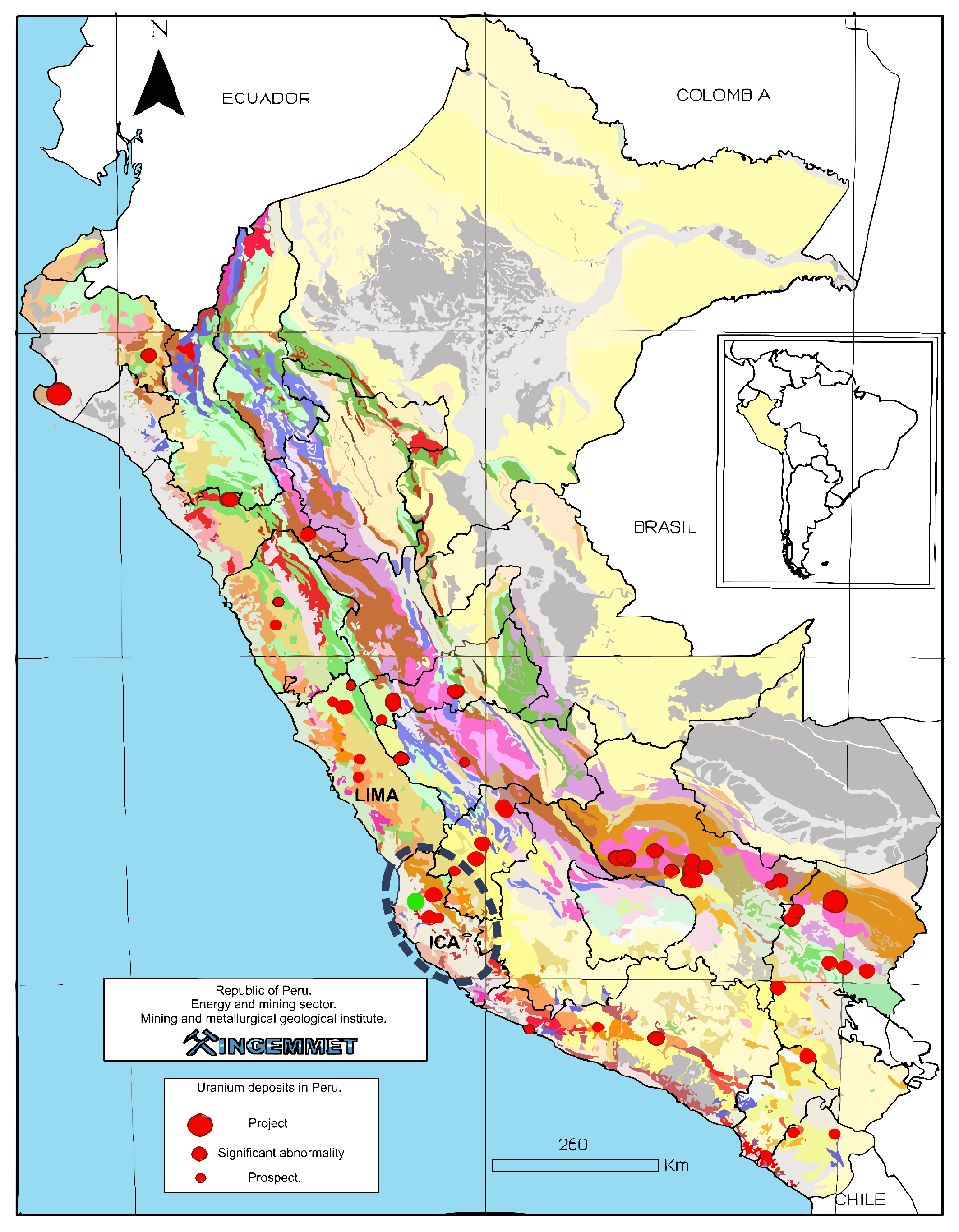

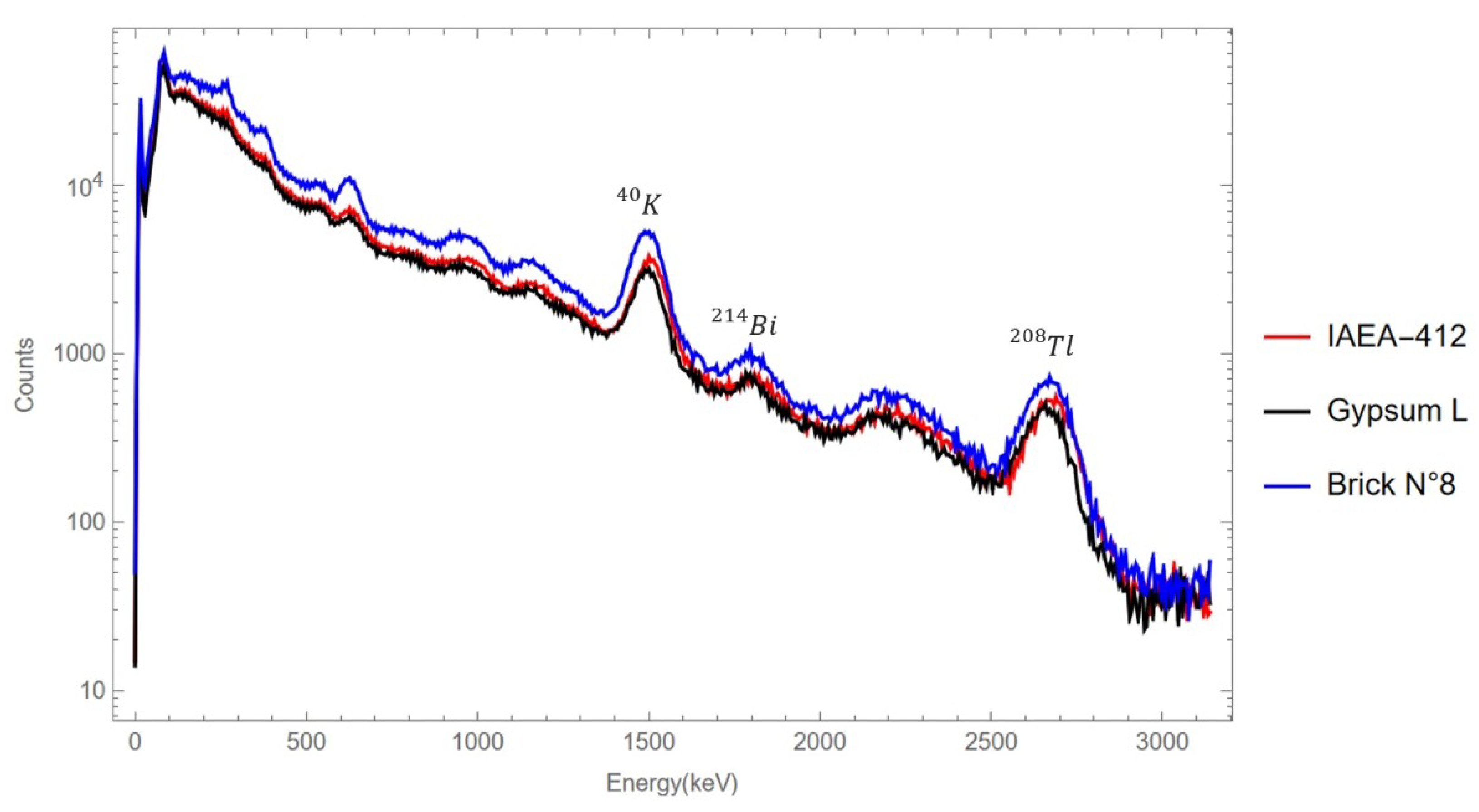
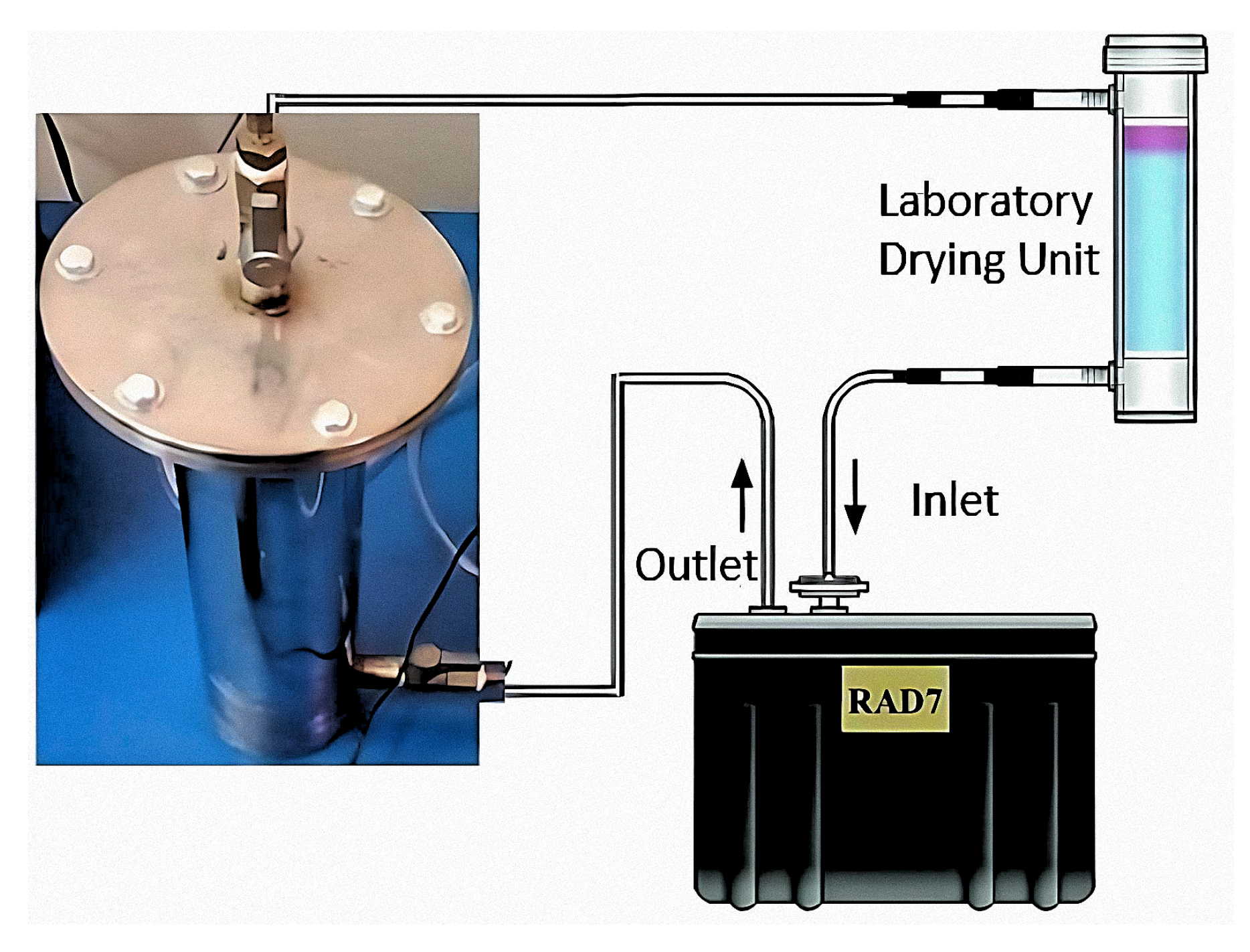
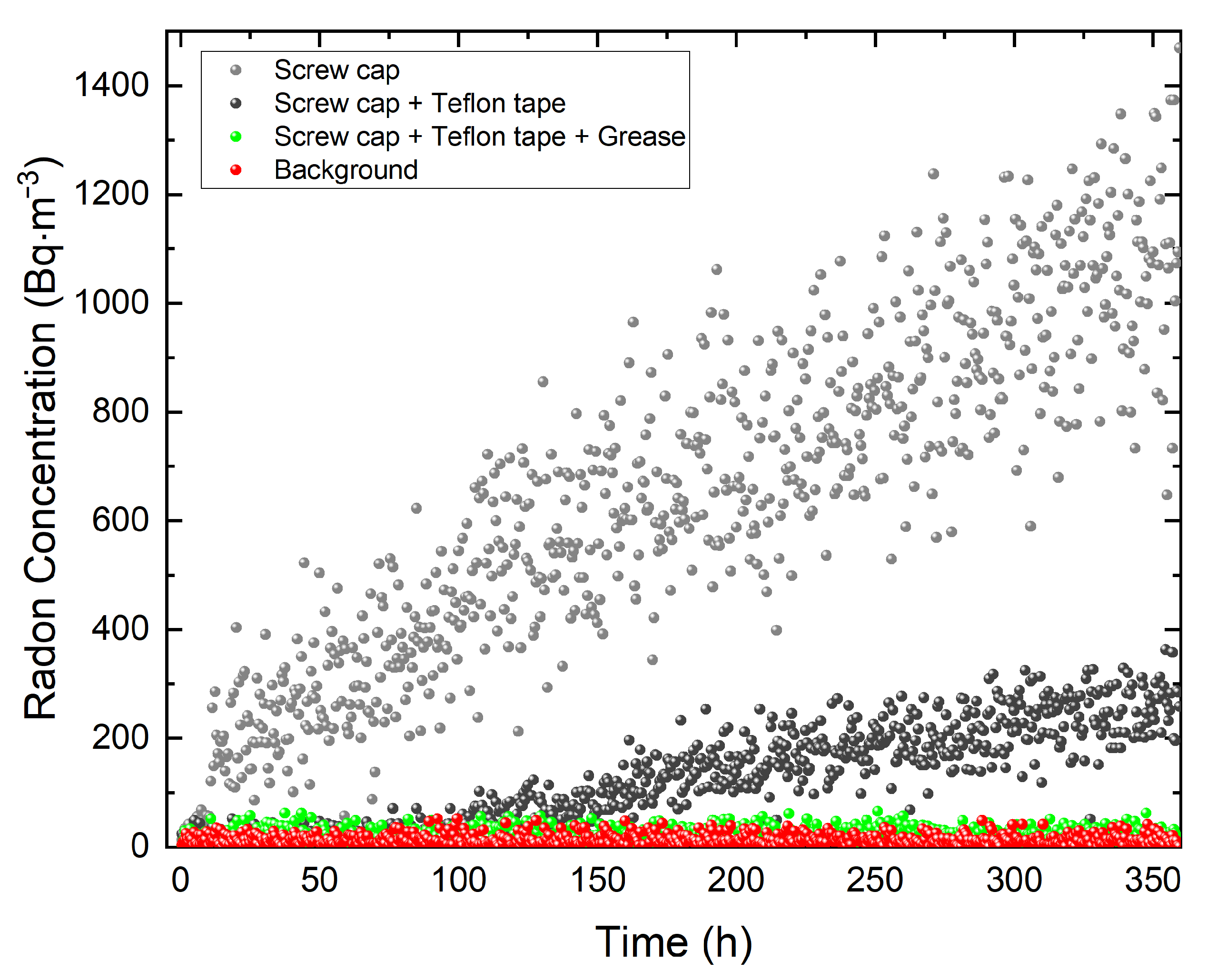

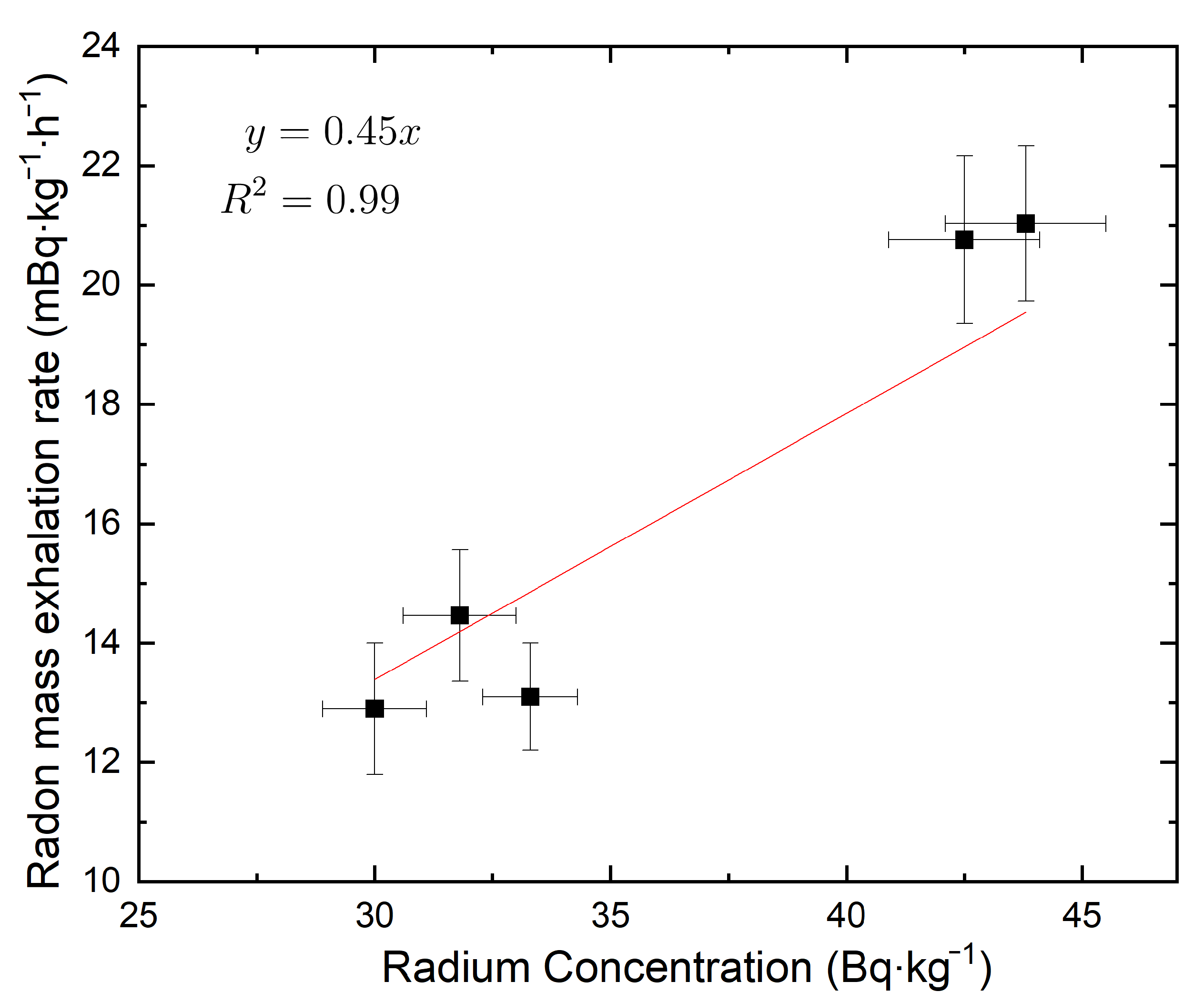
| Sample Building Materials * | Activity Concentration (Bq·kg−1) | ||||||
|---|---|---|---|---|---|---|---|
| Uncertainty (±) | Uncertainty (±) | Uncertainty (±) | |||||
| 1 | Cement S | 405 | 19 | 33.3 | 1.0 | 7.8 | 0.8 |
| 2 | Cement PR | 579 | 27 | 42.5 | 1.6 | 10.8 | 1.0 |
| 3 | Cement A | 347 | 16 | 31.8 | 1.2 | 7.8 | 0.8 |
| 4 | Cement PV | 356 | 17 | 43.8 | 1.7 | 9.9 | 1.0 |
| 5 | Cement Y | 821 | 39 | 30.0 | 1.1 | 9.5 | 0.9 |
| 6 | Sand G | 924 | 44 | 40.9 | 1.5 | 15.4 | 1.5 |
| 7 | Sand F1 | 898 | 43 | 23.8 | 0.9 | 7.7 | 0.7 |
| 8 | Sand F2 | 834 | 40 | 42.1 | 1.6 | 13.4 | 1.3 |
| 9 | Gypsum M | BDL | − | BDL | − | BDL | − |
| 10 | Gypsum L | BDL | − | BDL | − | BDL | − |
| 11 | Concrete | 667 | 33 | 44.4 | 1.7 | 19.6 | 1.9 |
| 12 | Rock | 452 | 21 | 28.7 | 1.1 | 10.8 | 1.0 |
| 13 | Brick P8 | 1067 | 51 | 60.6 | 2.3 | 21.4 | 2.1 |
| 14 | Brick P9 | 1074 | 51 | 50.6 | 1.9 | 22.3 | 2.2 |
| Samples | (Bq·m−3·h−1) | (mBq·kg−1h−1) | f (%) |
|---|---|---|---|
| Cement S | |||
| Cement PR | |||
| Cement A | |||
| Cement PV | |||
| Cement Y | |||
| Sand G | |||
| Sand F1 | |||
| Sand F2 | |||
| Gypsum M | BDL | BDL | |
| Gypsum L | BDL | BDL | |
| Concrete 1 | |||
| Rock C | |||
| Brick P8 | |||
| Brick P9 |
| Building Material | No. | ||||||
|---|---|---|---|---|---|---|---|
| Cement | 5 | Range | 0.26–0.42 | 0.19–0.29 | 0.27–0.39 | 33.87–53.83 | 0.17–0.26 |
| Average ± SD | |||||||
| Sand | 3 | Range | 0.42–0.52 | 0.28–0.36 | 0.35–0.47 | 53.09–66.73 | 0.26–0.33 |
| Average ± SD | |||||||
| Gypsum | 2 | - | - | - | - | - | - |
| Concrete | 1 | - | |||||
| Rock | 1 | - | |||||
| Brick | 2 | Range | 0.64–0.66 | 0.45–0.47 | 0.58–0.63 | 81.63–85.42 | 0.40–0.42 |
| Average ± SD |
| Country/ Reference | Samples | 226Ra (Bq·kg−1) | 232Th (Bq·kg−1) | 40K (Bq·kg−1) | ||||
|---|---|---|---|---|---|---|---|---|
| Hungary [41] | Cement | 19–251 (108) | 7–25 (17) | 36–110 (69) | 0.14–1.47 (0.67) | 0.09–0.79 (0.38) | 0.11–0.98 (0.47) | 0.4–1.29 (0.61) |
| Brick | 31–32 (32) | NR (31) | 473–484 (479) | 0.39–0.40 (0.40) | 0.30–0.31 (0.31) | NR (0.42) | 0.49–0.50 (0.50) | |
| Concrete | 9–13 (11) | 5–7 (6) | 115–169 (142) | 0.11–0.12 (0.12) | 0.08–0.09 (0.09) | 0.11–0.12 (0.12) | 0.13–0.15 (0.14) | |
| Iran [42] | Cement | 24–38 (31) | 11–18 (15) | 145–312 (231) | 0.24–0.31 (0.27) | 0.17–0.20 (0.19) | 0.23–0.27 (0.25) | 0.28–0.33 (0.30) |
| Brick | 20–39 (30) | 19–34 (28) | 167–536 (338) | 0.25–0.40 (0.34) | 0.18–0.29 (0.26) | 0.24–0.39 (0.35) | 0.28–0.46 (0.42) | |
| Gypsum | 10–13 (12) | 11–17 (14) | 66–172 (116) | 0.13–0.15 (0.14) | 0.10–0.11 (0.11) | 0.14–0.15 (0.15) | 0.16-0.17 (0.17) | |
| Poland [43,44,45] | Cement | 21.7–75.6 (48) | 12.3–47.3 (29) | 123–430 (238) | 0.35–0.67 (0.51) | 0.22–0.44(0.32) | 0.33–0.61 (0.47) | 0.40–0.74 (0.57) |
| Brick | (35.6) | (31.75) | (546.41) | ND | ND | ND | (0.098) | |
| Sand | 2–49(13.5) | 2.3–90.0 (9.4) | 26–770 (206) | ND | ND | ND | ND | |
| European Union [46,47,48,49] | Cement | 4–422 (45) | 3–266 (67) | 4–846 (216) | ND | ND | ND | 0.10–3.01 (1.03) |
| Brick | 2–148 (47) | 2–164 (48) | 12–1169 (598) | ND | ND | ND | 0.15–2.34 (1.01) | |
| Gypsum | 22–668 (318) | 5–55 (19) | 3–151 (58) | ND | ND | ND | ND | |
| India [50] | Sand | 42.6–92.7 (70.81) | 45.2–95.6 (77.10) | 409.5–777.10 (575.20) | 0.61–0.95 (0.80) | 0.46–0.70 (0.61) | 0.63–0.93 (0.81) | 0.10–0.15 (0.12) |
| Cement | 35.8–69.5 (55.26) | 45.0–77.4 (64.61) | 55.8–133.3 (97.83) | 0.35–0.64 (0.52) | 0.28–0.50 (0.41) | 0.40-0.71 (0.58) | 0.06-0.10 (0.08) | |
| Brick | 36.4–80.9 (63.0) | 35.7–73.2 (53.78) | 292.6–492.3 (405.02) | 0.43–0.81 (0.62) | 0.32–0.61 (0.47) | 0.41–0.81 (0.61) | 0.07–0.13 (0.10) | |
| Brazil [51,52] | Sand | 40.3–134.0 (66.7) | 15.1–136.0 (40.6) | 289.0–1019.0 (647.0) | ND | ND | ND | 0.33–1.06 (0.51) |
| Cement | NR (62) | NR (59) | NR (564) | ND | ND | ND | ND | |
| Brick | 9.5–70.0 (46.8) | 12.7–488.6 (119.9) | 149–553 (349) | ND | ND | ND | ND | |
| Argentina [53] | Cement | 6.4–34.0(16.3) | 11.6–14.1 (13.0) | 199–247 (228.8) | ND | ND | ND | ND |
| Sand | 3.7–45.8 (20.1) | 4.7–90.0 (33.8) | 85–1168 (522) | ND | ND | ND | ND | |
| Gypsum | 1.6–9.5 (5.8) | <2 | 6–59.7 (25.7) | ND | ND | ND | ND | |
| Present study | Cement | 30–43.8 (36.28) | 7.8–10.8 (9.16) | 347–821 (501.6) | 0.27–0.39 (0.34) | 0.19–0.29 (0.24) | 0.26–0.42 (0.33) | 0.17–0.26 (0.21) |
| Brick | 50.6–60.6 (55.8) | 21.4–22.3 (21.85) | 1067–1074 (1070.5) | 0.58–0.63 (0.61) | 0.45–0.47 (0.46) | 0.64–0.66 (0.65) | 0.40–0.42 (0.41) | |
| Concrete | (44.7) | (19.6) | (667) | 0.58–0.63 (0.61) | 0.45–0.47 (0.46) | 0.64–0.66 (0.65) | 0.40-0.42 (0.41) | |
| Sand | 23.8–42.1 (35.6) | 7.7–15.4 (12.16) | 834–924 (885.3) | 0.35–0.47 (0.42) | 0.28–0.36 (0.33) | 0.42–0.52 (0.47) | 0.26–0.33 (0.30) |
Disclaimer/Publisher’s Note: The statements, opinions and data contained in all publications are solely those of the individual author(s) and contributor(s) and not of MDPI and/or the editor(s). MDPI and/or the editor(s) disclaim responsibility for any injury to people or property resulting from any ideas, methods, instructions or products referred to in the content. |
© 2024 by the authors. Licensee MDPI, Basel, Switzerland. This article is an open access article distributed under the terms and conditions of the Creative Commons Attribution (CC BY) license (https://creativecommons.org/licenses/by/4.0/).
Share and Cite
Liza, R.; Pereyra, P.; Muñoz, D.; Viera, V.; López Herrera, M.E.; Rojas, J.; Palacios, D.; Díaz, F.; Cerna, N.; Rojas, S.; et al. Comprehensive Study of Natural Radioactivity in Building Materials: A Case Study in Ica, Peru. Atmosphere 2024, 15, 279. https://doi.org/10.3390/atmos15030279
Liza R, Pereyra P, Muñoz D, Viera V, López Herrera ME, Rojas J, Palacios D, Díaz F, Cerna N, Rojas S, et al. Comprehensive Study of Natural Radioactivity in Building Materials: A Case Study in Ica, Peru. Atmosphere. 2024; 15(3):279. https://doi.org/10.3390/atmos15030279
Chicago/Turabian StyleLiza, Rafael, Patrizia Pereyra, Daniel Muñoz, Victor Viera, Maria Elena López Herrera, Jhonny Rojas, Daniel Palacios, Félix Díaz, Nhell Cerna, Segundo Rojas, and et al. 2024. "Comprehensive Study of Natural Radioactivity in Building Materials: A Case Study in Ica, Peru" Atmosphere 15, no. 3: 279. https://doi.org/10.3390/atmos15030279
APA StyleLiza, R., Pereyra, P., Muñoz, D., Viera, V., López Herrera, M. E., Rojas, J., Palacios, D., Díaz, F., Cerna, N., Rojas, S., & Sajo-Bohus, L. (2024). Comprehensive Study of Natural Radioactivity in Building Materials: A Case Study in Ica, Peru. Atmosphere, 15(3), 279. https://doi.org/10.3390/atmos15030279











